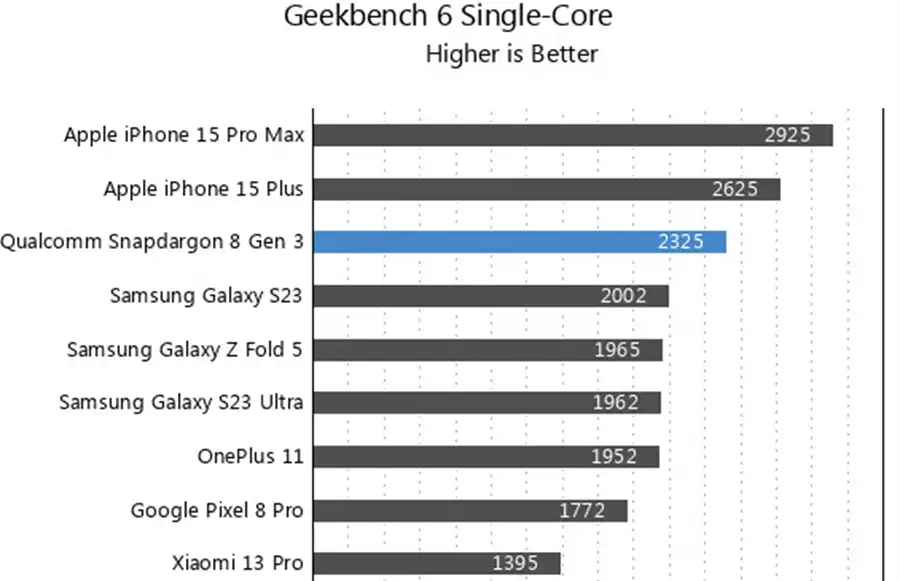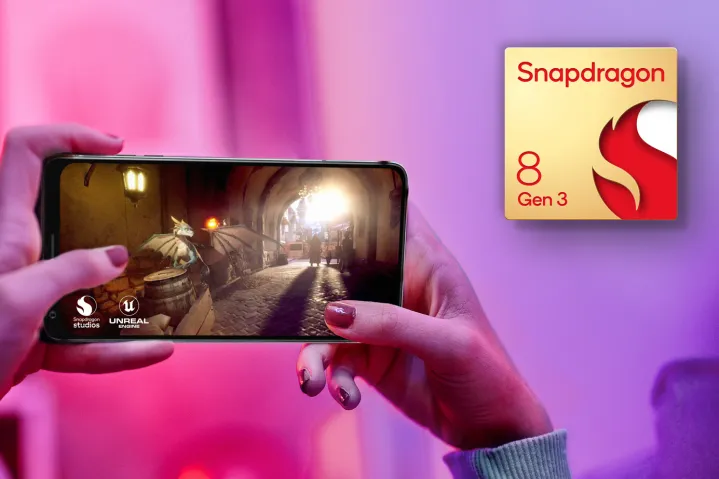Table of Contents
In the ever-evolving world of smartphones, two giants, Qualcomm and Apple, have revealed their latest flagship System-on-Chips (SoCs) — the Snapdragon 8 Gen 3 and the Apple A17 Pro. These powerful processors are set to dominate the high-end smartphone market in 2024. But how do they stack up against each other in terms of performance? Let’s explore the Snapdragon 8 Gen 3 vs. Apple A17 Pro face-off.
Under the Hood: Cores and Architecture
While both the Snapdragon 8 Gen 3 and A17 Pro are Arm-based SoCs, the way they achieve their prowess is fundamentally different. Qualcomm, a licensee of Arm’s CPU cores, participates in the Cortex-X Custom Program. This means the Snapdragon 8 Gen 3 boasts Arm’s top-end Cortex-X4 performance core. On the other hand, Apple is the sole smartphone vendor designing its cores based on Arm’s architecture, deviating from off-the-shelf CPU core designs.
The difference in CPU cores complicates direct comparisons based on clock speed or core count. Apple’s cores are generally larger and individually more powerful, while Qualcomm’s octa-core setup historically closed the gap through sheer core quantity. Additionally, the A17 Pro enjoys the advantage of a newer 3nm process node, offering potential improvements in efficiency and peak performance.
Performance Face-Off: Benchmarking Insights
In the realm of benchmarking, Apple’s custom Arm cores propel the A17 Pro to a notable 26% lead in Geekbench 6’s single-core test. However, Qualcomm’s Snapdragon 8 Gen 3, with its five mid-tier cores and two efficiency cores, manages to outscore the A17 Pro in multi-core workloads. Despite the Snapdragon 8 Gen 3’s reference device displaying commendable performance, the real-world scenario might differ in retail devices due to thermal or design constraints.

Gaming and GPU Dominance
The Snapdragon 8 Gen 3 emerges as the GPU powerhouse, showcasing a 32% lead over the A17 Pro in 3DMark’s Wildlife Extreme benchmark and a 37% advantage in the Solar Bay ray-tracing test. Although the A17 Pro supports full console games like Resident Evil Village, the Snapdragon 8 Gen 3’s gaming potential suggests a promising future for Android gaming. Apple’s App Store, however, has strategically cultivated a range of developers, including AAA console gaming experiences, making the A17 Pro an enticing choice for certain gaming enthusiasts.
Apple A17 Pro Vs Snapdragon 8 Gen 3
| Specifications | Apple A17 Pro | Snapdragon 8 Gen 3 |
| CPU | Six-core CPU, 19 billion transistors | Octa-core, Kryo CPU |
| Process Technology | TSMC’s 3nn process(N3B) | TSMC’s 4nn process |
| GPU | Apple Pro-class 6-core GPU Hardware-accelerated raytracing | New Adreno GPU(750) Unreal Engine Global illumination |
| AI & Machine Learning | 16-core Neural Engine; 35 TOPS | New Hexagon AI Engine |
| ISP | Apple-designed Image Single Processor | New Cognitive ISP |
| Video Capability | 4K60 ProRes videos Spatial video recording 4K HDR Dolby Vision @60fps | Night Vision for Darker scenes |
| Wi-fi Support | Wi-Fi 6E | Wi-Fi 7 |
| Bluetooth | Bluetooth 5.3 | Bluetooth 5.4, LE Audio Dual Bluetooth Antenna aptX Lossless |
| Others | AV1 Decorder ProRes codec NaviC Support | AV1 Codec Support NaviC Support Snapdragon Seamless |
AI and Additional Features
Artificial Intelligence (AI) takes center stage as Qualcomm and Apple adopt distinct approaches. Qualcomm emphasizes AI with the Snapdragon 8 Gen 3, showcasing nearly double the power of the previous generation and catering to generative AI applications. Apple, while not explicitly boasting about AI performance, introduces specific features in the A17 Pro, focusing on improved autocorrect and object detection.

Beyond AI, the chips diverge in other areas. Apple introduces ray tracing graphics and AV1 video decoding for the first time on the A17 Pro, while the Snapdragon 8 Gen 3 secures wins in Wi-Fi 7 support, 8K video recording, and 8K display output.
Final Talk:
In the Snapdragon 8 Gen 3 vs. Apple A17 Pro showdown, the choice becomes nuanced, considering the ecosystem preferences and individual priorities of users. The Snapdragon 8 Gen 3, destined for the Android realm, impresses with its graphics capabilities, AI advancements, and promising pricing expectations in the $700 to $800 segment. Apple’s A17 Pro, with a focus on gaming and a higher entry cost starting at $1,000 for the iPhone 15 Pro, caters to a dedicated iOS user base.
As the smartphone landscape continues to evolve, the Snapdragon 8 Gen 3 and A17 Pro exemplify the pinnacle of mobile processing power. Whether you’re enticed by Android’s potential or Apple’s commitment to gaming, both SoCs promise a high-end smartphone experience. The choice between them ultimately boils down to the user’s allegiance to a particular ecosystem and their preferences in terms of gaming, AI capabilities, and pricing.
In the coming months, all eyes will be on flagship releases from major players like Samsung’s Galaxy S24 series, expected to feature the Snapdragon 8 Gen 3. Until then, the Snapdragon 8 Gen 3 and Apple A17 Pro stand as testaments to the relentless pursuit of innovation in the world of smartphone technology.
Also Read: iPhone 15 Pro Max vs Galaxy S23 Ultra: A Comprehensive Comparison

